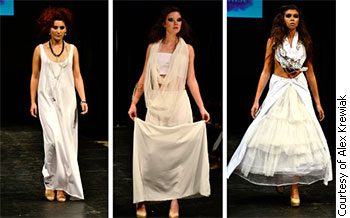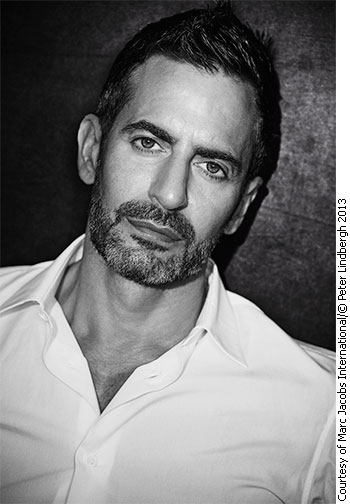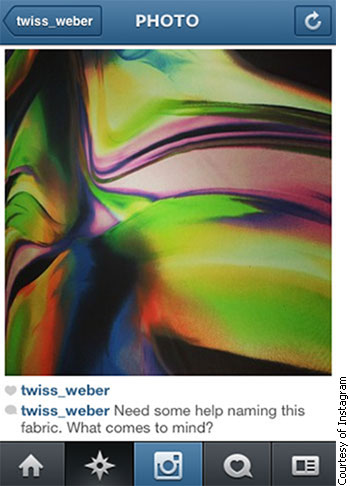Tags
Related Posts
Share This
Hearing voices: Designers gain feedback on Instagram
Inspired by the idea of “creepy fairytales,” designer Alex Krewiak wove together textures and volumes of white fabric for the spring/summer 2014 collection of her A.M.K. fashion brand, for a timeless, “natural” effect. At their showing at Calgary Fashion Week in September, the clothes were punctuated with necklaces of layered metal chains and pearls, white feather earrings and bracelet cuffs resembling tree branches. The models walked with matted, messy hair and charcoal-smudged eyes.

Models walk the runway during Calgary Fashion Week sporting pieces from A.M.K.’s spring/summer 2014 collection, which was researched entirely through Instagram.
Yet Krewiak’s raw, organic designs were derived from research done entirely through something contrastingly unnatural: the photo-sharing mobile app Instagram.
Growing quickly
Launched in October 2010 by two Stanford University graduates, Instagram is a visually based social networking app. Users can apply digital filters to photos and videos taken on their phones, and share them on their Instagram profile or on other social networking services like Twitter, Facebook and Tumblr. Originally available only on iPhones, Instagram later expanded to be compatible with Androids, and, most recently, there is a simplified version of the app for online profiles.
‘Art has never been created in a vacuum, but perhaps the creative environment is opening up.’ — media expert Jessica Melnik
In April 2012, Facebook bought Instagram for $1 billion. As of September 2013, the app has 150 million users. According to a recent study by L2 Think Tank, which analyzes and reports on social media trends, Instagram has a 900 percent annual growth rate.
Each day there are an average 55 million photos shared, and 1.2 billion “Likes” on photos. Krewiak, for example, says she’s on Instagram “at least 10 times a day.” Indeed, the highly visual platform is appreciated by many creative people. Jessica Melnik is the creative director at Impact Communications, a media relations company based in Peterborough, ON, and a freelance art director and photographer. “I think visually, and Instagram is a good way to keep that visual part of my brain active, interested and exercised,” she said in an email.
It’s no wonder that with such soaring popularity, the app has attracted droves of designers and fashion industry professionals, who are using it for showcasing their products, for research and for inspiration. Interestingly, though, the app has also created a new avenue for designers, into the minds of consumers.
In your head
Designers are starting to use Instagram — which L2 Think Tank says has 25 times the level of engagement as that of community-based platforms like Facebook — to get feedback and ideas from their consumers. American fashion designer Marc Jacobs, for example, posted a picture of three chain necklaces on his Instagram account and asked his followers,

Marc Jacobs is one top designer who now uses Instagram to invite consumer comment.
“Gold, rose gold or silver,” inviting their opinions. In a similar manner, Ottawa-based fashion brand Twiss & Weber recently posted a picture of a new prismatic fabric and wrote, “Need some help naming this fabric. What comes to mind?” The brand later posted on its blog that its consumers chose the name Aurora.
It’s this type of engagement that causes some to argue that the traditional practice of designers maintaining creative control is starting to change. Maureen Mullen, head of research for L2 Think Tank, told the New York Times in September that “Designers are treating consumers like artists, people who for the first time are creating aspirational content that brands want to use.”
Melnik agrees. “There are a lot of really talented, smart shoppers and consumers who have valuable things to contribute,” she says. “I don’t believe art is or has ever been created in a vacuum, but perhaps the creative environment is opening up.”
Some observers say that the tradition of designer creative control is starting to change.
For designer Krewiak, this kind of collaboration is now the next step. First, she says, she used Instagram for research and to promote her work and her brand. “Now I’m going to start using it to get feedback,” she says, “it’s a direct line to the consumer.” Melnik concurs, saying this type of collaboration is really important for artists who sell to the general public.
But not all designers are using Instagram for inspiration. Evan Clayton is a designer based in Vancouver. “Personally I don’t think it influences me much as a designer,” he says. Clayton says he utilizes Instagram primarily for marketing: “I’m usually inspired by totally different things and just use Instagram to showcase my work to clients.” For example, his latest collection (called “KIN”), for spring/summer 2014, was inspired by Japanese historical costumes and David Attenborough documentaries on the Pacific Northwest, the latter of which would be particularly difficult to find on Instagram.
Changing the industry?
Yet with the many other designers who are using the app for inspiration and to get into consumers’ heads, such collaboration and engagement could have future large-scale effects on the fashion industry. Melnik explains that most trends follow a classic

A post on the Twiss & Weber Instagram page invites followers to suggest names for a newly designed fabric.
boom-and-bust cycle, where they begin as a sub-cultural tendency before developing a larger following and eventually becoming popular in mainstream culture. More and more people catch on, until eventually the trend either dies, is replaced, or changes into something new. “I wonder if it will lead to faster cycling of trends,” says Melnik in regard to Instagram. “If you have more people contributing to the development of trends, as well as the propagation and distribution of these trends via social media, then it could be assumed that the cycle itself would speed up.” Since more people have access to a particular trend, it may become “cool” more quickly, and in turn die more quickly.
This faster cycle could be either bad or good. “Burnout rates are pretty high and it’s difficult for artists and creatives to stay on top of trends, even just technology-wise,” says Melnik. “It’s easy to get overwhelmed or just tired of the constant flow of material.” On the flip side, a constant flow of ideas could be productive: “The faster trends cycle, the more creative people have to be to come up with something new and meaningful while still building on past developments. This leads to innovation,” Melnik says.
Only time will tell if and how Instagram could significantly affect the fashion industry. For now, at the very least, it serves as a fun way for users to share their lives and express themselves and, for some designers, an efficient research tool and method for client feedback.
Home-page photo courtesy of Alex Krewiak.
A treasure trove of images
Instagram is influencing the research and inspiration processes of some industry professionals.
Fashion designer Alex Krewiak says her method of getting inspiration is different from what it was pre-Instagram. "Before, I would research by looking at pictures online or flipping through magazines and physically cutting out pictures that I thought were neat," she says. "[The app] has made it so much faster and so much more accessible. I now have a big research folder on my laptop just with photos that I screen captured from Instagram."
This accessibility is fostered through Instagram's hashtag search system. As with Twitter, users can add hashtags in the captions of their photos or in a comment. Viewers and followers can then tap on the hashtag and see all the photos with the same tag. This feature allows everyone — users, their friends and strangers — to contribute to and view the enormous hashtag-organized pool of photos.
Krewiak says the app has supplied a pool of inspirational sources that she didn't have access to previously. "You get so much more underground fashion and underground art that is really cool and on trend," she says. "It's opened up a lot of doors to find this great content that you necessarily wouldn't have been able to before," she explains, noting that she now has better access to local fashion sources like bloggers, photographers and other designers.





